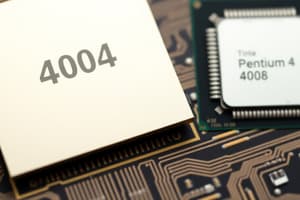Podcast
Questions and Answers
What was the clocking frequency of the introductory versions of the Pentium microprocessor?
What was the clocking frequency of the introductory versions of the Pentium microprocessor?
- 90 MHz and 120 MHz
- 50 MHz and 75 MHz
- 60 MHz and 66 MHz (correct)
- 80 MHz and 100 MHz
How did the cache size of the Pentium microprocessor compare to the basic version of the 80486?
How did the cache size of the Pentium microprocessor compare to the basic version of the 80486?
- It increased to 16K bytes (correct)
- It remained the same at 8K bytes
- It increased to 32K bytes
- It decreased to 4K bytes
What was one significant improvement in the memory system of the Pentium microprocessor compared to the 80486?
What was one significant improvement in the memory system of the Pentium microprocessor compared to the 80486?
- 64-bit data bus width (correct)
- 32-bit data bus width
- Improved clocking speed
- Up to 2G bytes storage capacity
What additional feature did recent versions of the Pentium microprocessor include?
What additional feature did recent versions of the Pentium microprocessor include?
What systems were upgraded by the long-awaited Pentium OverDrive (P24T) according to the text?
What systems were upgraded by the long-awaited Pentium OverDrive (P24T) according to the text?
Which statement about the Pentium Pro processor is true?
Which statement about the Pentium Pro processor is true?
What is the main reason for placing the Pentium II microprocessor on a small circuit board?
What is the main reason for placing the Pentium II microprocessor on a small circuit board?
What is the speed of the onboard L2 cache on the Pentium II module?
What is the speed of the onboard L2 cache on the Pentium II module?
Which of the following statements about the Pentium II microprocessor is false?
Which of the following statements about the Pentium II microprocessor is false?
What was the reason for increasing the bus speed of the Pentium II microprocessors from 66 MHz to 100 MHz?
What was the reason for increasing the bus speed of the Pentium II microprocessors from 66 MHz to 100 MHz?
Flashcards are hidden until you start studying
Study Notes
Pentium Pro Microprocessor
- Contains 21 million transistors, integer units, and a floating-point unit to increase software performance.
- Initial clock frequencies were 150 MHz and 166 MHz, released in late 1995.
- Features 16K level-one (L1) cache (8K for data and 8K for instructions) and a 256K level-two (L2) cache.
- Uses three execution engines to execute up to three instructions simultaneously, even if they conflict.
- Optimized for 32-bit code execution, often bundled with Windows NT.
- Can address 4G-byte or 64G-byte memory systems, with a 36-bit address bus for 64G memory systems.
Pentium II Microprocessor
- Released in 1997, featuring a new direction in design with a small circuit board.
- L2 cache is placed on the main circuit board, operating at 133 MHz with 512K bytes of storage.
- The microprocessor on the Pentium II module is a Pentium Pro with MMX extensions.
- Bus speed changed in 1998, with newer Pentium II microprocessors using a 100 MHz bus speed.
- Higher-speed memory bus (100 MHz) used in Pentium II microprocessors rated at 350 MHz, 400 MHz, and 450 MHz.
Pentium Microprocessor
- Introduced in 1993, similar to the 80386 and 80486 microprocessors.
- Originally labeled the P5 or 80586, but Intel changed the naming convention.
- Initial versions operated at 60 MHz and 66 MHz clock frequencies, with a speed of 110 MIPs.
- Later versions included 100 MHz, 120 MHz, and 133 MHz clock frequencies.
- Features 16K-byte cache, with 8K-byte instruction and data caches.
- Supports up to 4G bytes of memory, with a 64-bit data bus.
- Includes multimedia extensions (MMX instructions) in newer versions.
Studying That Suits You
Use AI to generate personalized quizzes and flashcards to suit your learning preferences.




